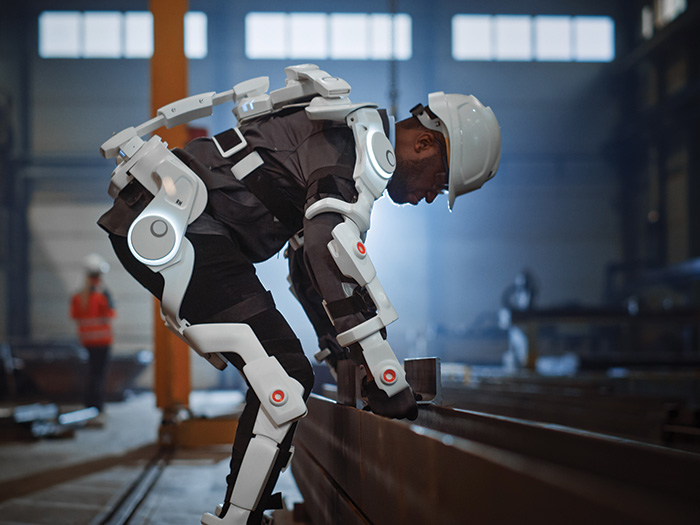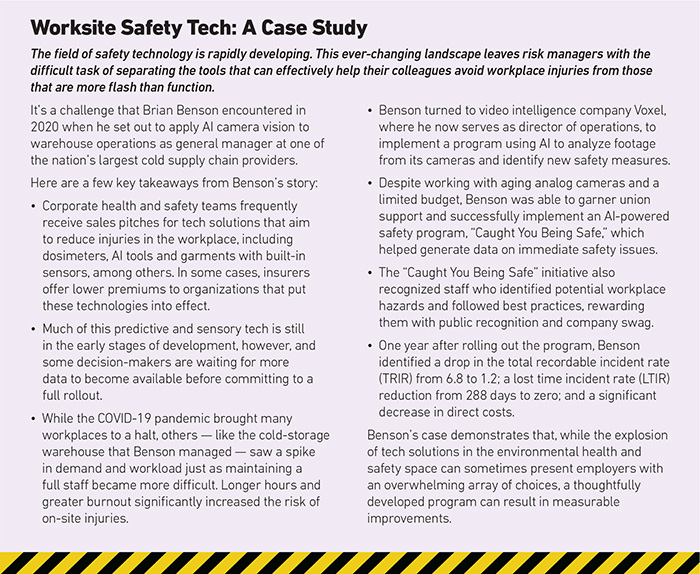An $8 Billion Dollar Market by 2027? Safety Wearables and the ROI Necessary for Their Ascent

Wearable technology for consumers has become so ubiquitous, it’s no longer a stretch to assume that smartwatches and fitness trackers are a part of getting dressed every day. For industry, however, the efficacy and return on investment of the numerous safety wearables on the market — that is, whether they actually prevent injuries and reduce workers’ compensation claims — is still an open question.
While purveyors of the tech tout massive benefits, end users and the risk managers assessing the data aren’t quite ready to go for broke and implement these programs on an enterprise-wide basis. The reasons for this are primarily research lag and early adopter bias, but the workers’ compensation and risk management industries are leading the charge to ultimately determine whether wearables’ benefits are worthy or weak.
Jesse Jacobs, product director, science & research, risk control services, global risk solutions for Liberty Mutual, joined the company in 2015 and began a research portfolio addressing chronic pain and fall risk in the workplace.
“The biggest promise of wearables is that we can move from these long-term observations, with safety managers watching employees for several hours at a time, to getting more rapid and scaled results on an entire workforce, looking at their risk over the course of their entire day rather than at isolated tasks,” Jacobs explained. “You can risk-assess at the scale of your entire job force.”
This economy of scale makes sense for some businesses, which is likely why research indicates huge growth in the space. Market research firm The Insight Partners expects a combined annual growth rate of 15% for industrial wearables specifically (most of these are considered safety wearables) from 2020 to 2027. If this comes to pass, the market will be worth $8.63 billion in just four years.
However, growth in and of itself is not an indication of value. For that, industry leaders need data to substantiate their investments. That’s where the picture gets fuzzy for most risk managers.
The Drive for Better Data
“The data surrounding safety wearables has historically been fragmented due to the onus being on companies, for the most part, to collect it,” said Dan Fegel, national manager of risk management and loss control services for PCF Insurance.
“Additionally, because the data being reported is predominantly manually collected, it’s safe to assume that the data being reported is limited to the company, and its quality would be dependent upon the accuracy of the investigation to determine root causes, as well as subject to the reliability and consistency of each company’s employees at reporting incidents and near-misses.”
In other words, human error plays heavily into the assessment and gathering of the data — and it can’t be easily extrapolated.
To combat this (and to develop actionable data sets for key client partners in the process), some workers’ comp service providers are positioning themselves as expert pilot program organizers.

Jesse Jacobs, product director, science & research, risk control services, global risk solutions, Liberty Mutual
Michelle Despres, VP of product management and national clinical leader at One Call, assesses the efficacy of wearables in numerous ways across programs, including surgery rates, return-to-work data and physical therapy expenses. She noted that this is a new frontier and that they continue to look for these strategic solutions because they believe in the value of the technology.
“We’re looking at aggregating [data from wearables] across multiple workers to ask whether there is a job-specific risk that exists and maybe a job category that can be improved,” she explained.
“Once we identify that, we can implement the technology and use it to scale compliance over time to see if the risk value has changed and determine if more potential solutions need to be implemented,” Despres continued. “So when we look at the benefits, it’s still kind of early. We don’t have the numbers to say that if you invest a dollar here you get a three-dollar return.”
Debatable ROI
It’s no surprise, then, that the companies making safety wearables have a desire to prove their efficacy, both as a marketing function and to ensure that funding and desire for these pilot programs exist for industry and risk managers. For some of these tech-driven enterprises, the published results are eye-popping.
“The companies that experience the most success with wearables are the ones that commit to deploying and managing the program,” said Haytham Elhawary, cofounder and CSO of Kinetic Insurance. “We work closely with each customer to integrate the wearables into their operation, guide them in change management and provide education for all parties.
“When successfully adopted, the tech leads to some pretty stellar results. The Kinetic wearable is verified to reduce strain and sprain injuries by 55%, missed workdays by 72% and overall claims costs by up to 50%.”
The study Elhawary cites was conducted in April 2021 with actuarial film Perr&Knight. The combined authors state succinctly in the final report that “the reduction in frequency of strain and sprain claims when wearing the Kinetic device will lead to a reduction in overall claim costs as these claims are eliminated.”
It’s the “will lead” in that central claim that garners skepticism. For his part, Jacobs with Liberty Mutual says that these studies are not definitive. “We don’t have that reduction in terms of seeing long-term changes in claims rates,” said Jacobs.
“When you look at the scientific literature as well, really that literature has been focused on the manual material handling use case, and right now that literature has not identified a significant benefit,” Jacobs continued. “What they’ve identified is, for example, that posture-based wearables can effectively change posture, but they don’t necessarily prove a change in risk or injury rates.”
These challenges are one reason why partnerships remain the most common investigative research method employed across the board.
Who Is Telling the Story?
In 2017, EMC Insurance began investing and partnering with wearables company MakuSafe to assist with product development through testing and feedback.
 For Chad Veach, AVP of risk improvement innovation at EMC, the results have been impressive in the context of a larger risk management strategy, a result and general modus operandi echoed by other leaders in the space.
For Chad Veach, AVP of risk improvement innovation at EMC, the results have been impressive in the context of a larger risk management strategy, a result and general modus operandi echoed by other leaders in the space.
“Some clients who have taken advantage of the data insights and have implemented appropriate risk controls have improved their work comp loss frequency between 40 and 80%,” Veach said.
“More time and data are needed to determine the full extent of the measurable impact, but it is apparent MakuSafe’s wearable sensors can be extremely valuable and effective in the hands of a company that wants to take an active role in improving workplace safety.”
MakuSafe’s own data cites even more impressive numbers: a reduction in workers’ comp claims frequency of 50% or more, and in claims severity of 90%.
According to Jacobs, because the academic literature lags the industry’s pace, it’s really the innovators and early adopters that are creating the literature, and that is valuable as the literature develops, for individual companies and the workers they’re trying to keep safe.
“What we’ve found is that the practical capability of a business to run these trials in a scientifically rigorous way is challenged by the need to continue operations. Oftentimes, there are some tradeoffs in the validity for the sake of being able to engage in an active workplace, but we find that if you start small and narrow your scope to feasibility, usability and employee acceptance, that’s a good short-term first step.”
With market growth maintaining a breakneck pace, we’ll know soon enough whether these devices are keeping their promise. &










